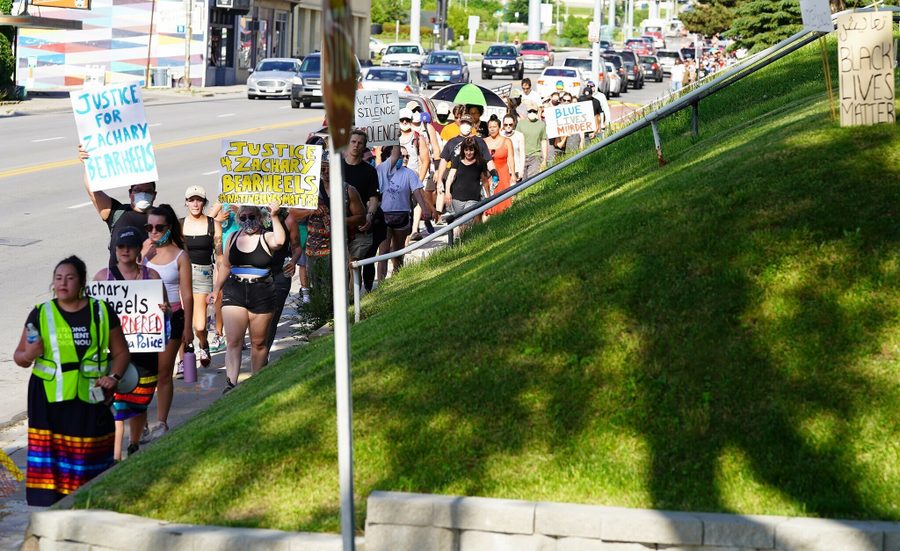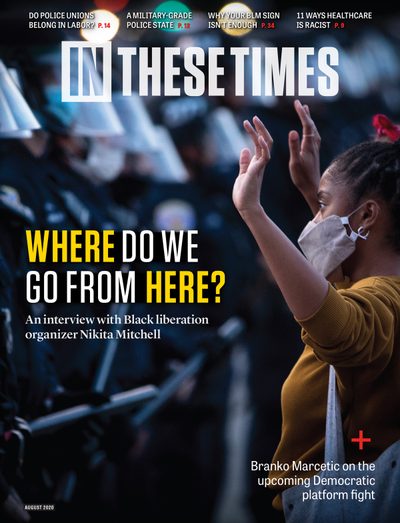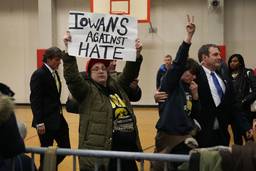Protesting Native Deaths by Police
Amid protests against police violence nationwide, a march was held in remembrance of a Native man who died in police custody while suffering a mental health crisis.
Elena Carter

OMAHA, NEB. — Kateri Hinman Petto’s feet began to bleed during the 4-mile walk from the downtown Greyhound bus station to Bucky’s Convenience Store. But stopping wasn’t an option. Nearly 200 people were behind her and, besides, she thought, this was nothing compared to what Zachary Bear Heels had gone through. Bear Heels, a 29-yearold Rosebud Lakota man, died in police custody outside Bucky’s on June 5, 2017. He was dehydrated, confused and in a mental health crisis.
At the march, Petto raised her megaphone and said his name. The crowd, gathered to retrace Bear Heels’ final steps on the third anniversary of his death, called back “Zachary Bear Heels” and chanted “Native Lives Matter.”
Bear Heels had been traveling to Oklahoma City by bus when he was kicked off for “erratic behavior” at the Omaha station, according to Indianz.com. Relatives say Bear Heels, who struggled with bipolar disorder and schizophrenia, had not been taking his prescribed medication. He wandered Omaha for two days. Authorities found him dancing in front of Bucky’s.
Bear Heels, who was not under arrest or being detained, refused to get into a police cruiser. A struggle ensued. Police then shocked Bear Heels a dozen times with a taser (including three times after he stopped resisting) and repeatedly punched him in the head, ultimately smothering him on the pavement, handcuffed, under the weight of several officers, one of whom weighed 275 pounds.
“I think about him every day,” says Les Chalepah, Bear Heels’ cousin, who grew up with Bear Heels in Oklahoma. “He was just a happy person,” Chalepah says.
The June 5 demonstration was the second memorial walk held in honor of Bear Heels. He was one of 33 Native Americans to be killed by police in 2017, according to the website Fatal Encounters.
Native deaths by police rarely make national headlines, but Native Americans are more likely to be killed by police than any other racial or ethnic group (and 3.1 times more likely to be killed by police than whites), according to a 2016 investigation by In These Times, “The Police Killings No One Is Talking About.” People with untreated mental illness are 16 times more likely to be killed by police than others.
“In today’s society, we’re invisible,” Petto says. “People don’t realize that we’re contemporary people.”
Marisa Miakonda Cummings, a member of the Omaha tribe and a mother whose children are Native and African American, emphasized the need to stand in solidarity with the Black Lives Matter movement. “We know as Indigenous people that 99% of us were killed off,” she said at the memorial walk. “We need allies.”
Others at the walk held signs bearing the name James Scurlock, a 22-year-old African American man killed by a white bar owner May 30 during a George Floyd protest in Omaha.
The county coroner determined Bear Heels died a “sudden death associated with excited delirium.” Excited delirium syndrome is a controversial label that has not been recognized by the American Medical Association or the American Psychiatric Association, but is not uncommonly cited as a cause of death for victims in police custody. The syndrome is supposedly characterized by agitation, delirium, high body temperature, unexpected strength and sudden death. Most fatalities attributed to excited delirium occur after a person has been asphyxiated while restrained.
The coroner’s report helped officer Scotty Payne, charged with felony assault, achieve a verdict of not guilty, though he was fired. (The other three officers involved were initially fired but were reinstated in April.) Some legal experts think the officers charged in George Floyd’s death may try to incorporate the syndrome in their defense.
Native journalist and activist Kevin Abourezk has covered the Bear Heels case extensively for Indianz.com. He suspects the officers involved were immediately concerned with building an excited delirium defense, suggested by the fact that they got in the ambulance with Bear Heels’ body.
A wrongful death suit filed against the city by Bear Heels’ mother is ongoing.
Kimara Snipe, a member of the Omaha Public Schools Board, spoke about the need for diversity and training and to change policies around police restraint and deadly force. Terrell McKinney, running for state legislature, reminded the crowd the Omaha police contract is up for renegotiation.
“I’m 100% for a more diverse police force,” Petto says, “but we need to address the systemic racism that exists within our police force and … [gets excused] in our judicial system. Our rally was a good opportunity for the Native community and the Black community to come together.”
Marchers closed the day with a prayer song and a moment of silence.
“We need to keep demanding justice,” Chalepah says. “They need to understand how we feel, how Zach’s death weighs heavy on our hearts.”






